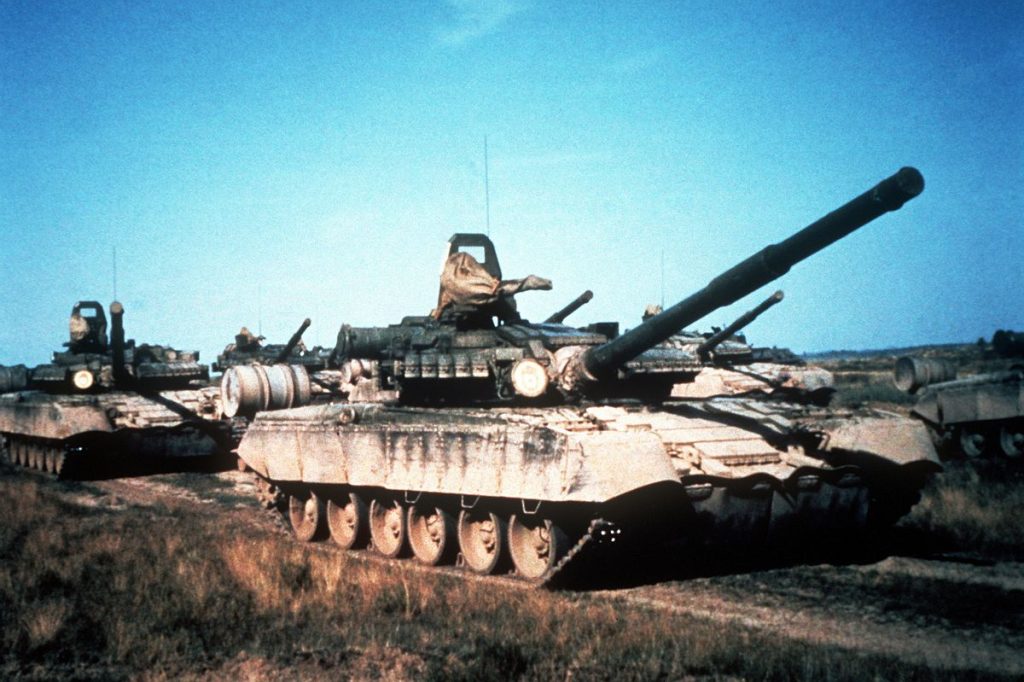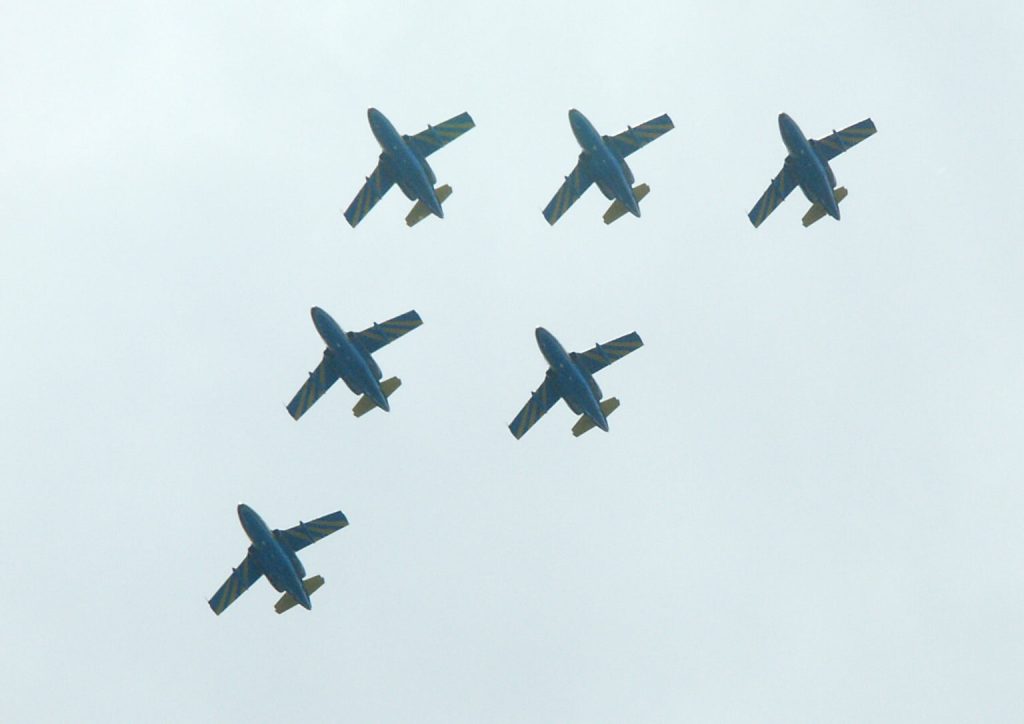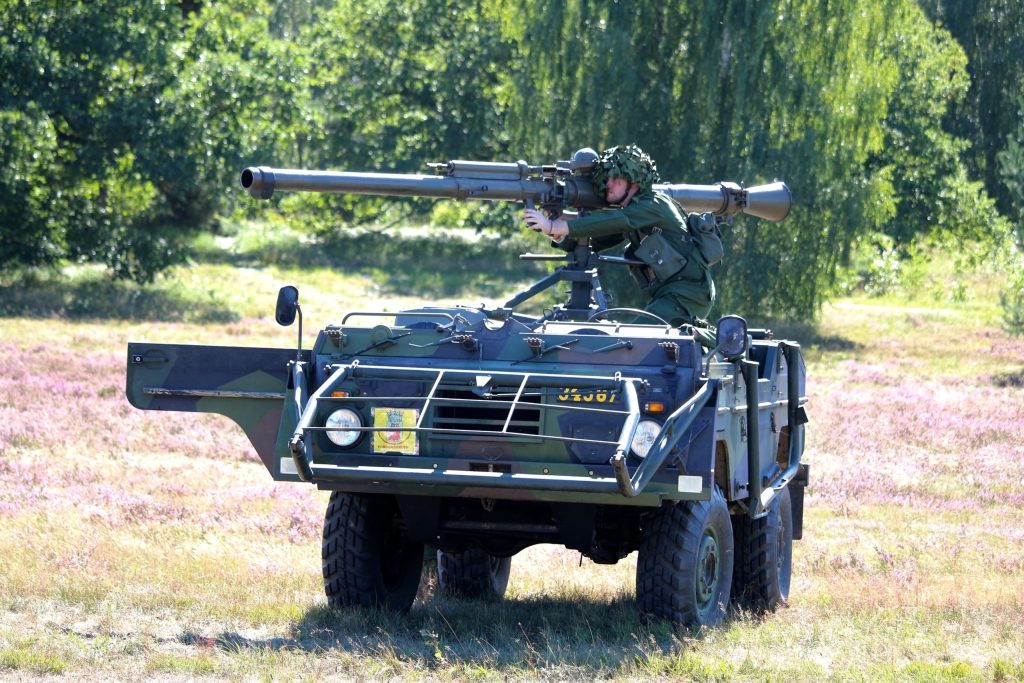The armoured threat
At the end of the Second World War in 1945 the then Soviet Union had built up a large and powerful force of tanks. The combination of tanks, artillery and air support had been demonstrated as a winning concept during the War and every country tried to implement this knowledge. As the Soviet Union had been forced to fight a devastating war deep inside its own territory, it wanted to avoid this happening again. By ensuring that it was surrounded by states that were subjugated and more or less of a friendly inclination, and also building up a large and powerful tank strength, the plan was to meet any enemy on the enemy’s own ground.

Type T-80 tanks. It was vehicles like this that the Hkp9 was intended to stop. Image source Wikimedia. Commons
The tanks were soon complemented by armoured personnel carriers (APC), themselves armed at a similar level as light tanks from the Second World War and inside which troop units could be carried with protection against shell splinters and hand-held guns. If necessary these protected troops could be deployed and support tank attacks. These APC could be combined with artillery that itself was on caterpillar tracks and protected by light armour.
When the Cold War between the NATO western alliance and the Soviet-led Warsaw Pact became a reality, the potential threat from a Soviet tank army became a major problem for NATO. Certainly there were small tactical nuclear weapons that could be employed, but both sides were well aware of the dangers implied by nuclear attack. If one side used nuclear weapons, even in limited numbers, the other would be sure to use its own tactical nuclear weapons and an escalation would begin, leading to a full scale nuclear war.
Consequently both side strove as far as possible to win a possible conflict with conventional weapons and with the absolute minimum employment of the nuclear arsenal. We now know that Soviet planning did envisage a limited use of nuclear weapons in the hope that this would give a surprise attack enough time to overwhelm the NATO forces in Europe before the USA could send over sufficient reinforcements. However the tip of the attacking force would consist of motorised divisions in a combination of armour, firepower and movement.
Swedish planning
During the Cold War Sweden built up, considering the size of the country, a huge defensive force. When mobilized this would involve every eighth Swedish citizen. However even when as much money was spent as possible, it was obvious that it was not enough, especially as it would be necessary to engage in every type of warfare.
One decision that was taken immediately after the Second World War was to determine that a strong Air Force would be absolutely necessary in in any future conceivable war. Even today Sweden has for its size a large Air Force, even though it cannot be compared to the Swedish Air Force in its heyday during the 1950s. At that time Sweden had the fourth largest in the world. A large investment was made in producing its own hyper-modern jet fighters at a not inconsiderable cost.
This led however in the long run to the various defence departments becoming all the more at odds in respect of how the available resources should be committed. For the Navy’s part and not least that of the Army too, it seemed that they were always getting the short end of the stick due to the Air Force needs. The Air Force view was that to a large extent it was they who would be the determining factor in the case of war. If it was possible by means of a major attack to eliminate a Soviet invasion force in the Baltic harbours, the Navy and the Army would manage to repel any remaining enemy units that managed to land. If the Air Force failed, it would not matter a great deal how much modern material the Army had.
It was the Swedish Army and Navy who recognized the helicopter’s potential and chose to invest in them, whilst at first the Air Force rejected helicopters as having little importance. Only later did the Air Force acquire helicopters, after they had proved that they had an excellent ability to quickly be able to save pilots who had been forced to eject from their aircraft.
Nor did the Air Force regard direct support for Sweden’s ground troops as a priority, instead focusing on air defence and the strategic attack tasks in depth on the enemy units, and as previously mentioned on harbours and enemy shipping. Over time, however, light attack divisions were equipped with the SK60 to thereby play a part in time of war as air support for ground troops.

A group of SK60 during an airshow. In case of war these school planes would have been used as light ground attack Photo: Peter Langsdale
Troubles for the Army
The Swedish Army was however aware of the way that fighting morale could be affected within its own troops, partly positively by having their own air support, but also negatively by being exposed to enemy air attack while believing they would not get support from their own aircraft or seeing the enemy getting some of their own medicine. Direct air support had been shown to be very effective during World War 2, above all due to the double effect on the fighting morale of both own and enemy troops. The actual damage was often much less than first envisaged, but as the famous French General Napoleon stated, the relationship between morale and actual physical strength was in the ratio of three to one. That is to say that a small force with a high battle ethic is worth 3 times as much as an opposing force where the fighting morale is low.
At an early stage the Swedish Army began to consider the possibilities of using armed helicopters to support ground troops. At the Helicopter School trials were carried out, with among other things machine guns being fitted to Hkp2s, although they never went beyond the trials stage. Even the possibility of arming helicopters with armour-piercing missiles was examined, and in 1965 three Hkp3s were equipped with the anti-armour missile 53 Bantam from Bofors. At the same time trials were carried out to establish how vulnerable a helicopter would be against fighter aircraft and to see how a helicopter could reduce the risk of both detection and being shot down. The Air Force was however totally convinced that a helicopter, even flying very low, would be an easy target for a fighter aircraft. A number of tests were done over the years and foreign experience was also studied. The experience of the US in Vietnam was naturally interesting, although interpreted in different ways.
It was nevertheless clear that some of the vehicles that had been successfully attacked were similar to those that Sweden could be sure to meet if the country was dragged into a war between NATO and the Warsaw Pact. Also the helicopter-borne TOW missiles had been shown to be effective.

The light all-terrain vehicle Type Tgb 1111 was another system that tried to solve the problem of having a mobile anti-tank unit that could be inserted where needed. Photo Jorchr Wikimedia commons.
One difficulty in meeting an armoured attack is that such units can move relatively quickly, even across terrain with no roads, and make deep intrusions. An attacker also has the advantage of deciding where to attack, while the defender must try to gather together a small amount of resources where an attack is most likely or alternatively to locations where there is an absolute need and wish to mount a defence. So in order to be able to mount a defence in an unexpected direction a defender must also have access to forces that can be quickly regrouped to meet an attacker. Here the ability of a helicopter to land almost anywhere is of great importance, and as a first stage the idea was that a helicopter could transport anti-armour units to wherever they were needed. However the next stage would be to use armed helicopters and quickly concentrate them at the threatened area to contribute to increasing defensive firepower wherever most needed. The helicopters could unexpectedly arrive and attack enemy vehicle columns.
A Swedish solution inspired by Germany
A great deal depended on economics. Investing in specialized attack helicopters was thought by some to be a waste of resources. Therefore the focus came to lie on anti-armour helicopters whereby standard helicopters could be armed with armour-piercing missiles and both operate at a distance and create ambushes.
The large German order for 212 MBB Bo105 anti-armour helicopters probably influenced the Swedish decision. However there was a long drawn out discussion by the newspaper handbills between the Army brass who promoted the acquisition of fighting helicopters and the Air Force equivalents who wanted new proposed SAAB B3LA light attack aircraft that would be able to provide close support for the Army. This would also have generated job opportunities for SAAB, who were expected to develop that type of aircraft. It took a long time, but the advantage of acquiring a helicopter that could both act as a transport and be armed with armour-piercing missiles emerged and the choice fell on the Bo 105, which was assigned the Swedish designation of Hkp 9. The German Army was in turn helpful with advice and support, so that finally 20 Hkp 9As were supplied to Sweden’s Army Aviation. At the same time the Swedish Air Force ordered four unarmed Hkp 9s to supplement its aviation rescue service.

An unarmed Hkp9 in Swedish camouflage colours. Photo: Peter Langsdale
